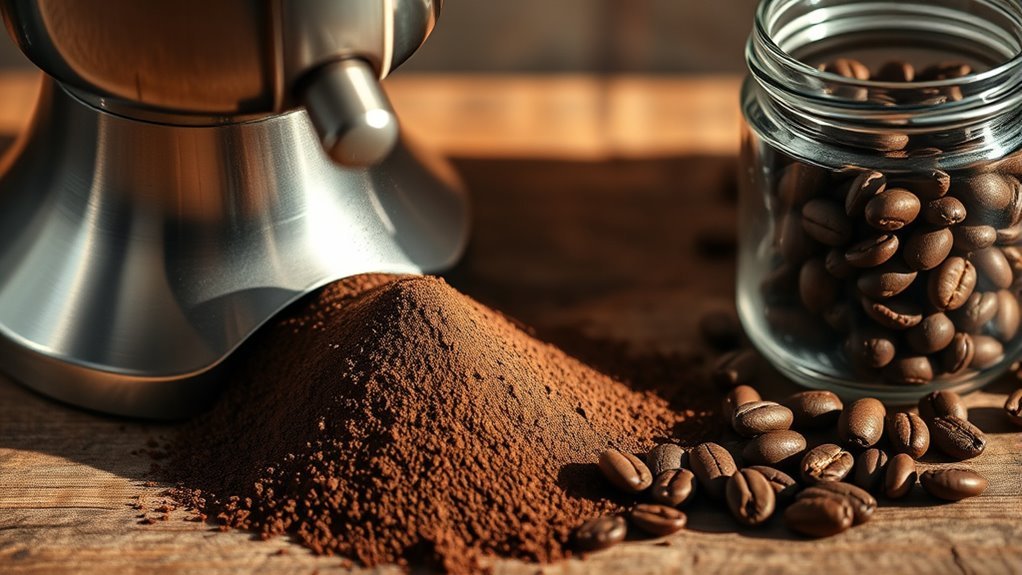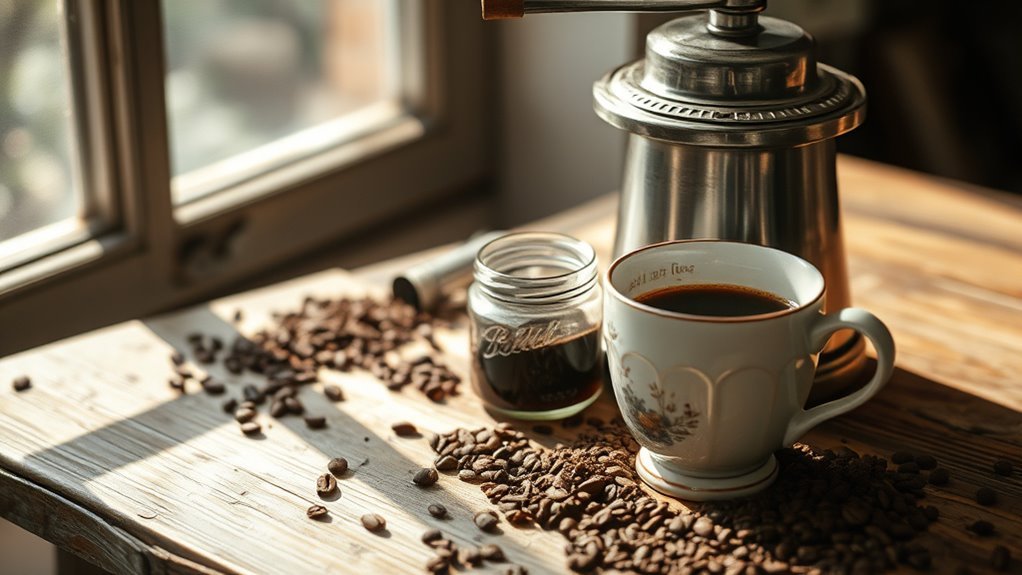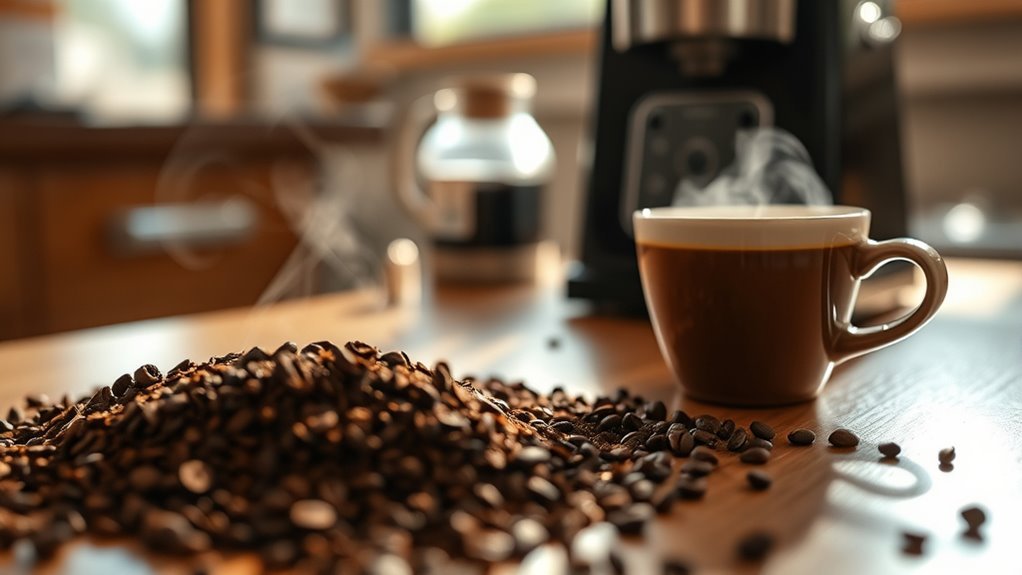Can You Regrind Coffee
Yes, you can regrind coffee to achieve a more uniform grind size, which helps with extraction and flavor. It lets you adjust the grind for different brewing methods. However, be cautious; regrinding can expose coffee to air, leading to flavor degradation and aroma loss. To maximize your coffee experience, consider the grind size carefully. You’ll discover more tips and insights on how to make the most of your coffee journey.
Understanding Coffee Grind Size

When you explore the world of coffee, understanding grind size is essential, as it can make or break your brewing experience. The grind consistency directly impacts extraction efficiency, which determines the balance of flavors in your cup. A coarse grind allows for a slower extraction, perfect for methods like French press, while a fine grind is ideal for espresso, maximizing flavor in a short time. If your grind isn’t consistent, you risk over-extraction or under-extraction, leading to bitterness or sourness. Each brewing method demands a specific size for best results, and getting it right liberates your taste buds. So, embrace the art of precision in grinding, and elevate your coffee experience to new heights. Your freedom to savor every sip begins here.
The Science Behind Coffee Freshness
Grind size plays an essential role in extracting flavors, but freshness is equally important in determining the quality of your coffee. When coffee is ground, it exposes more surface area to air, accelerating coffee oxidation. This process leads to flavor degradation, diminishing the vibrant notes you crave. Ideally, you want to brew with freshly ground coffee, as it captures those rich, aromatic compounds that give each cup its unique character. Even a short delay can compromise that experience—once ground, the clock’s ticking. To savor the freedom of true coffee enjoyment, aim to minimize the time between grinding and brewing. Prioritize freshness to guarantee every sip reflects the best your coffee has to offer, free from the dullness of oxidation.
Benefits of Regrinding Coffee

Although many coffee enthusiasts advocate for using freshly ground beans, regrinding coffee can offer some surprising benefits. You might find that regrinding techniques allow for versatile brewing methods, enhancing your coffee flavor in unexpected ways. By adjusting grind size, you can tailor your brew to suit your taste preferences or experiment with different brewing styles.
| Benefit | Description | Impact on Flavor |
|---|---|---|
| Consistency | Achieves uniform grind size | Enhances extraction |
| Customization | Allows for size adjustments | Tailors flavor profile |
| Convenience | Uses leftover grounds effectively | Reduces waste |
| Experimentation | Encourages trying new methods | Expands flavor horizons |
Embrace the freedom to explore! Regrinding can reveal a new world of coffee enjoyment.
Potential Drawbacks of Regrinding
While regrinding may seem like a practical solution for maximizing your coffee experience, it does come with certain drawbacks that shouldn’t be overlooked. First, regrinding can lead to flavor dilution. When you grind coffee beans multiple times, you expose them to more air, which can cause the essential oils to evaporate, diminishing the rich flavors you crave. Additionally, you risk significant aroma loss, as the volatile compounds responsible for that enticing scent are fragile and can dissipate quickly. This means that your coffee may taste flat and lack the vibrant notes you love. If you’re passionate about your brew, it’s essential to weigh these drawbacks against the potential benefits before deciding to regrind. You deserve a coffee experience that’s truly exceptional.
Best Practices for Regrinding Coffee

When regrinding coffee, aiming for the ideal grind size is essential to achieving the best flavor extraction. You’ll also want to take into account your equipment carefully, as not all grinders are created equal—some can overheat the beans or produce uneven grounds. By paying attention to these factors, you can elevate your coffee experience even when regrinding.
Ideal Grind Size
Choosing the ideal grind size for regrinding coffee is essential to releasing the full potential of your beans. You want to guarantee grind consistency for peak flavor extraction. Here’s a quick guide to help you find that perfect grind size:
| Grind Size | Brew Method | Flavor Profile |
|---|---|---|
| Coarse | French Press | Bold, Robust |
| Medium-Coarse | Pour Over | Balanced, Rich |
| Medium | Drip Coffee | Smooth, Clean |
| Fine | Espresso | Intense, Concentrated |
| Extra Fine | Turkish Coffee | Strong, Complex |
Keep these options in mind as you regrind. The right choice can elevate your coffee experience, giving you the freedom to enjoy every flavorful sip.
Equipment Considerations
To achieve the best results when regrinding coffee, investing in the right equipment is essential. Not all grinders are created equal; you’ll want to choose a grinder type that suits your brewing method. Burr grinders are often preferred for their consistency, allowing you to control grind settings with precision. If you regrind, adjust your settings to avoid over-extraction and bitterness.
Keep in mind that the grind size can change the flavor profile considerably, so experiment to find your ideal balance. Always clean your grinder between uses to prevent stale or mixed flavors. With the right tools and a little experimentation, you can access the full potential of your coffee beans, ensuring every cup is a masterpiece.
Comparing Freshly Ground vs. Reground Coffee
While many coffee enthusiasts swear by the superior flavor of freshly ground coffee, regrinding can sometimes be a practical solution, especially if you’ve got leftover grounds. A fresh grind offers unmatched flavor intensity, capturing the essential oils and aromas that define a great brew. The complex notes unfold beautifully, creating a rich experience that regrinding often can’t replicate. When you regrind, you’re risking the breakdown of those delicate compounds, which can lead to a duller taste. However, if you’re in a pinch, regrinding can still deliver a decent cup, just with less vibrancy. Ultimately, if you seek the purest coffee experience, prioritize fresh grinds, but don’t shy away from using what you have when necessity calls.
Creative Ways to Use Leftover Coffee Grounds

Leftover coffee grounds are more than just waste; they can be transformed into useful resources for your home. You can enrich your garden by using them as a natural fertilizer or pamper your skin with a rejuvenating exfoliant scrub. Embracing these creative uses not only reduces waste but also enhances your daily life in surprising ways.
Fertilizer for Plants
Coffee grounds are more than just a byproduct of your morning brew; they can be a fantastic fertilizer for your plants. By engaging in coffee composting, you’re not only reducing waste but also enriching your garden with essential nutrients. These grounds are rich in nitrogen, which promotes healthy growth and vibrant blooms. You can sprinkle them directly onto the soil, mix them into potting mix, or add them to your compost pile for effective nutrient recycling. Your plants will thrive, and you’ll feel empowered, knowing you’re making a positive impact on the environment. So, next time you brew a cup, remember that those grounds can help you cultivate a flourishing garden while embracing sustainability.
Natural Exfoliant Scrub
Revitalize your skincare routine with a natural exfoliant scrub made from those used coffee grounds. Not only do they provide an eco-friendly solution, but they also offer incredible skin benefits. Here’s how to create your own natural scrub:
- Mix used coffee grounds with coconut oil for a moisturizing effect.
- Add honey for its antibacterial properties and extra hydration.
- Incorporate a few drops of essential oil, like lavender, for a soothing scent.
- Gently massage the scrub onto your skin in circular motions, then rinse.
This simple DIY scrub will leave your skin feeling rejuvenated and smooth. Embrace this natural approach and enjoy the freedom of using what you already have while treating your skin to nature’s best.
Tips for Storing Coffee to Maintain Freshness
Although you may be tempted to leave your coffee out in the open, proper storage is essential for preserving its freshness and flavor. To keep your brew vibrant, choose airtight containers made from glass or ceramic, avoiding plastic that can trap odors. Store your coffee in a cool, dark place, away from sunlight and humidity—your kitchen cupboard is perfect. Remember, freshness tips include grinding beans just before brewing to capture their full aroma. If you buy in bulk, consider freezing excess beans in small batches, but be careful to avoid moisture. Embrace these simple coffee storage practices, and you’ll reveal the freedom to enjoy each cup as it was meant to be—rich, flavorful, and invigorating.
Frequently Asked Questions
Can I Regrind Coffee Multiple Times?
Did you know that coffee grind consistency can impact your brew by up to 20%? If you’re considering regrinding coffee multiple times, it’s important to know that while you can, it may lead to uneven extraction and over-extraction. The regrinding effects can alter flavor, making it more bitter or dull. For the best taste, aim for a single, consistent grind, allowing your coffee to shine in all its glory. Enjoy freedom in your brewing journey!
Does Regrinding Affect Caffeine Content?
Regrinding coffee can definitely affect caffeine extraction. When you regrind, you’re altering the grind consistency, making the particles smaller and increasing surface area. This can lead to a quicker release of caffeine during brewing. However, if the grind becomes too fine, it might also result in over-extraction, which can lead to bitter flavors. So, while you may get more caffeine, it’s essential to balance grind consistency with flavor to achieve that perfect cup.
Is Regrinding Suitable for All Coffee Types?
When you think of espresso beans, you might imagine that perfect shot, rich and bold. But is regrinding suitable for all coffee types? Not quite. While it can enhance grind consistency for certain brews, it often leads to over-extraction and bitterness in others. For delicate coffees, the nuances can be lost. So, if you’re seeking freedom in flavor, be cautious with regrinding; it’s not a one-size-fits-all solution. Choose wisely for your brew!
How Does Water Temperature Impact Regrinded Coffee?
Water temperature plays an essential role in how effectively you extract flavors from regrinded coffee. If the water’s too hot, you risk over-extracting bitter compounds, while cooler water might lead to under-extraction, leaving your brew flat. Finding that sweet spot boosts brewing efficiency, ensuring you get the rich, nuanced flavors you’re after. By controlling temperature, you can truly enjoy the freedom of crafting your perfect cup, maximizing every sip’s potential.
Can I Regrind Coffee Using a Blender?
Yes, you can regrind coffee using a blender! While it’s not the most efficient method, it can work if you’re in a pinch. Just remember, the grind consistency might not match that of a dedicated grinder. Blenders can create uneven particle sizes, affecting your brew. If you value freedom in your coffee-making, experimenting with a blender can lead to unique flavors. Just be mindful of how it impacts your final cup!






